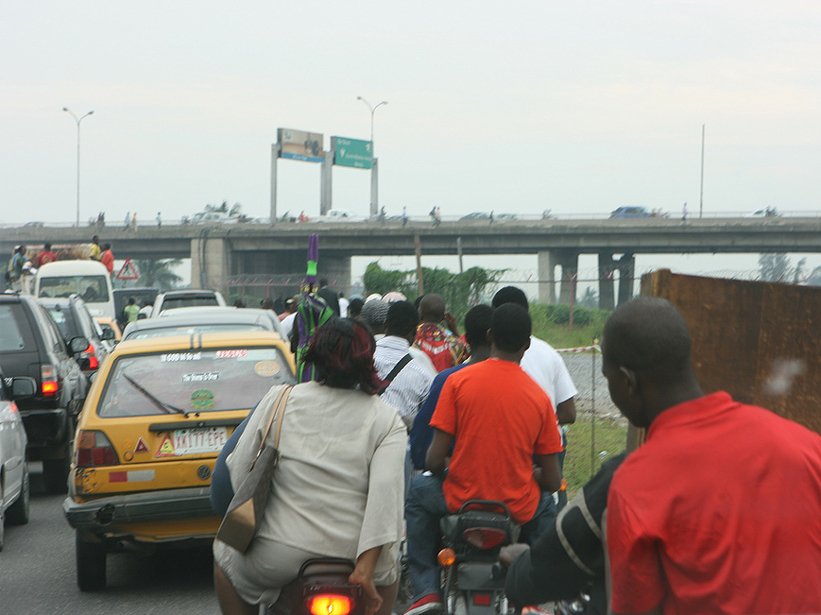West Africa is in need of continuous, long-term measurements to quantify the current and future atmospheric composition, identify emission sources, and better comprehend the impacts on human health, ecosystems, and climate.
West Africa has experienced rapid urbanization in recent decades. Lagos, Nigeria, is the most populated city in Africa, with more than 20 million inhabitants. Air quality there and in other West African cities is burdened by increasing anthropogenic emissions from exploitation of fossil fuels and other sources, in addition to the mix of biogenic emissions, fires, and dust that are specific to the region.
West Africa is in need of continuous, long-term measurements to quantify the current and future atmospheric composition, identify emission sources, and better comprehend the impacts on human health, ecosystems, and climate. For these reasons, the Centre for Atmospheric Research (CAR) of the Nigerian National Space Research and Development Agency (NASRDA) and the U.S. National Center for Atmospheric Research (NCAR) jointly organized a workshop on air quality, measurements, and modeling in Abuja, Nigeria, in mid-June 2014.
The workshop brought together 35 researchers, including graduate students, teachers, and scientists, from the region. The goal was to raise awareness of air pollution and associated impacts, identify existing air quality observations, discuss current and future research projects, and form new collaborations.

Ongoing research was presented on emission estimates; recent observations, including satellite and ground-based measurements; and modeling. There have been a few focused measurement campaigns, as well as limited surface observations that started in the 1990s. The upcoming Dynamics-Aerosol-Chemistry-Cloud Interactions in West Africa (DACCIWA) campaign scheduled for summer 2016 is expected to provide valuable air quality data. However, long-term surface observations currently do not exist.
Measurements and modeling were key themes of the workshop. These activities are, however, especially difficult and require devising ingenious solutions in a region fraught with challenges, such as an unstable electric grid, limited computational facilities, and background pollutants. Participants agreed that instruments must be not only affordable but rugged and capable of accurate measurements while exposed to environmental contaminants, especially dust.
These activities are, however, especially difficult and require devising ingenious solutions in a region fraught with challenges, such as an unstable electric grid, limited computational facilities, and background pollutants.
NCAR provided demonstration instruments, including an ozone monitor to start the first long-term measurements in Anyigba, Nigeria. Other instruments included a commercial nitric oxide/nitrogen dioxide monitor and low-cost sensor packages for observing other important air pollutants.
Workshop participants were introduced to the regional Weather Research Forecasting Model Coupled with Chemistry (WRF-Chem) and the global Community Earth System Model (CESM). Linux virtual machines with both models preinstalled were deployed on workstations connected to uninterrupted power supply systems to overcome power outages and limited Internet access at the meeting site. WRF-Chem helped workshop participants understand the emissions and atmospheric transport of pollutants in the region, and CESM illustrated the connections between regional and global air quality, with implications for climate change.
Despite limited funding and significant infrastructure challenges, the workshop achieved its set goals and was a great success for all the participants. A workshop website has been established as a communication portal for this collaborative effort.
Acknowledgment
The National Center for Atmospheric Research is sponsored by the National Science Foundation.
—Simone Tilmes, National Center for Atmospheric Research, Boulder, Colo.; email: [email protected]; Emiola O. Gbobaniyi, Centre for Atmospheric Research, National Space Research and Development Agency, Kogi State University Campus, Anyigba, Nigeria; John Ortega, National Center for Atmospheric Research, Boulder, Colo.
Citation: Tilmes, S., E. O. Gbobaniyi, and J. Ortega (2015), Fortifying international collaborations on African air quality, Eos, 96, doi:10.1029/2015EO025331. Published on 6 March 2015.
Text © 2015. The authors. CC BY-NC 3.0
Except where otherwise noted, images are subject to copyright. Any reuse without express permission from the copyright owner is prohibited.

